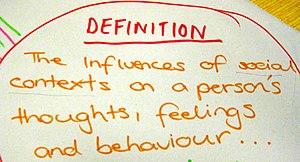Social psychology (psychology)/Tutorials/Introduction
| Resource type: this resource contains a tutorial or tutorial notes. |
| Completion status: this resource is considered to be complete. |
This tutorial provides an introduction to the Social psychology unit, sociometric exercises to explore student social groupings, and helps to develop student understanding and interest in social psychology.
Overview[edit | edit source]
- Use name tags
- Tutor introduction - and contact details
- Introduction to unit websites:
- Free and open educational philosophy, using wikis
- ucspace - for unit-specific information, e.g., dates, timeline, etc.
- wikiversity - for generic information, e.g., theories, research, etc.
- Google Groups - for group discussion (web/email forum)
- Cross-links facilitate moving between sites
- Discussion of assessment, particularly e-portfolio and essay topics.
 For students to do:
For students to do:
- Create a user account on Wikiversity and email the convener with your user name, real name, and student ID.
- Join the discussion group.
Sociometric icebreaker[edit | edit source]
In an open space, meet and greet one another by name (a la "cocktail party") and have a chat (the room will soon become noisy). After some time, the tutor announces a grouping characteristic. People are to arrange themselves according to the group to which they best belong (for tips and ideas, see categories). Some suggested groupings are:
- Eye colour (comment/discuss on use of eye color by Jane Elliott)
- Number of siblings (note the psychology of birth order research)
- Country of birth
- Where you live (arrange by North, South, East, West - for ideas, see People Map)
- Religion ("now for some harder ones!..." Organise according to actual beliefs (as opposed to 'offical' religion by birth) and inquire about why, strength of beliefs, etc.)
- Political voting behaviour (Who do you vote for?)
- Relationship status
- Person-situation debate (along a line/continuum; describe the extreme positions; ask those at the fartherest extremes to explain their views)
- "Computer-savviness".
Exploring social psychology[edit | edit source]
Individual[edit | edit source]

Individually write/brainstorm:
- A unique definition of social psychology (this should not be a regurgitation of the lecture/textbook).
- What you already know about social psychology (and closely related topics).
- What you don't know (and would like to know).
- Essay ideas and topic(s) you're interested in.
Small groups[edit | edit source]
In small groups (3 to 4), using three separate pieces of butchers paper, discuss, integrate and summarise:
- A definition of social psychology
- What your group knows about social psychology
- What your group doesn't know (but would like to know) about social psychology.
- Possible essay topics.
Large group discussion[edit | edit source]
If there are a small number of groups (e.g., ~3), then each group should share their responses/discussion of:
- Definitions (tutor should help repeat, emphasise, and critique aspects of the definitions - common issues include not focusing on ABC (Affect, Behaviour, and Cognition), and lack of focus on individuals within a social context (e.g., having an overly sociological focus))
- Areas of knowing
- Areas of not knowing and curiousity
- Possible essay questions
If there are a larger number of groups and/or lack of time, ask each group to share one of the four topics discussed.
Examples[edit | edit source]

See also[edit | edit source]
External links[edit | edit source]
- Introduction Tutorial (Wilderdom; 2007)
- Introduction Tutorial (ucspace)